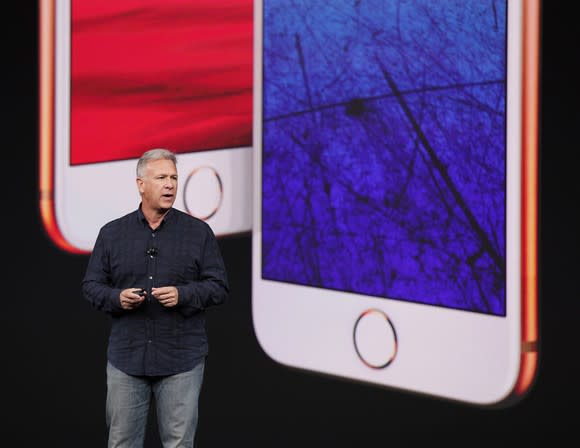Apple's iPhone X Supply Seems to Be Improving
MacRumors recently reported that the shipping estimates for Apple's (NASDAQ: AAPL) newly released and hotly anticipated iPhone X smartphone have improved from three to four weeks to just two to three.
That improvement in shipping time indicates that while Apple has not yet achieved supply-to-demand balance for these devices, it's getting closer to reaching that goal.

Image source: Apple.
Nobody likes to wait
The reality is that smartphones have a limited shelf life in the marketplace. Not only is a phone like the iPhone X going to be Apple's flagship device for at most a year, but demand for the phone near the end of the product cycle will drop as customers anticipate the introduction of next-generation iPhones.
To make matters worse, the smartphone market is fiercely competitive. New flagship smartphones from companies aiming to steal Apple's thunder launch all the time. So the longer it takes for Apple to fill demand for the iPhone X, the wider will grow the field of alternative devices consumers will be able to choose from while they wait for the iPhone X to become available.
It's therefore in the best interests of Apple to make sure it can fulfill demand for its latest smartphones as quickly as it can.
There were a lot of rumors ahead of the launch of the iPhone X that the company wouldn't be able to fully meet demand until sometime in the first half of 2018. While that may yet prove to be the case, the reported two- to three-week ship times, coupled with the fact that this ship time has shortened over the past few weeks, seems to indicate that Apple may reach supply to-demand balance sooner than that -- perhaps as early as next month.
If Apple can exit the year with iPhone X in supply-to-demand balance, that'd be a great achievement on Apple's part.
Some potential concerns
Although it's encouraging to see Apple catch up to the demand for the iPhone X, there's something that investors need to keep in mind: Achieving supply-to-demand balance is a function of both available supply and demand.
If Apple is coming closer to balancing supply and demand by dramatically improving the supply of its iPhone X through production efficiencies, something that's totally possible, then that's an unequivocal win for Apple and its stockholders.
However, if these ship times are becoming shorter simply because the initially quoted ship times were based on a high level of initial demand for the iPhone X that ultimately faded, then that could potentially be a negative for Apple.

Image source: Apple.
Another thing I'd be worried about is that analyst estimates for the current quarter seem to equate a failure to achieve supply-to-demand balance on the iPhone X with seeing demand pushed out into the following quarter.
In that case, there are two scenarios that I can see playing out. The first scenario would be that Apple reaches supply-to-demand balance sooner than expected, which means iPhone demand that would've been pushed out into the following quarter isn't pushed out and leads to better-than-expected iPhone revenue in the current quarter. That scenario would merely represent a pull-in of expected revenue and probably wouldn't affect investor expectations for full-year iPhone revenue.
The second scenario, which is more negative, would be where Apple achieves supply to-demand balance during the current quarter but doesn't report financial results that are much better than what analysts are expecting in the quarter. That would indicate that iPhone demand -- and, in particular, iPhone X demand -- is lower than what analysts expect, which would set Apple up to miss expectations when it provides financial guidance for the following quarter.
In that scenario, I could see Apple investors being disappointed, which could send investor expectations, and therefore Apple shares, lower.
More From The Motley Fool
6 Years Later, 6 Charts That Show How Far Apple, Inc. Has Come Since Steve Jobs' Passing
Why You're Smart to Buy Shopify Inc. (US) -- Despite Citron's Report
Ashraf Eassa has no position in any of the stocks mentioned. The Motley Fool owns shares of and recommends Apple. The Motley Fool has the following options: long January 2020 $150 calls on Apple and short January 2020 $155 calls on Apple. The Motley Fool has a disclosure policy.
